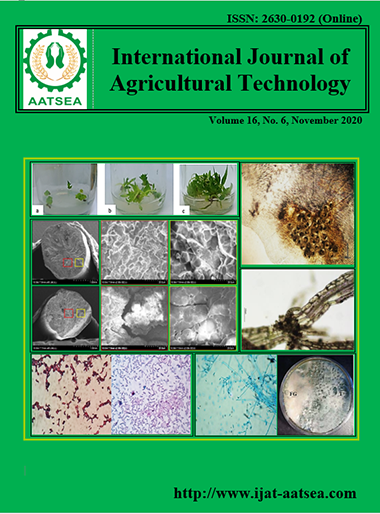Isolation and identification of nitrogen-fixing bacteria in the long-term fertility experiment in irrigated lowland rice ecosystem
Main Article Content
Abstract
Nitrogen-fixing bacteria makes up the large percentage of the soil environment and has a great role for plant growth promotion and anti-fungal activities. In this study, sixteen unknown bacteria were isolated from the control plot of NSIC Rc158 rice variety in the Long-Term Fertility Experiment of Philippine Rice Research Institute in Science City of Muñoz, Nueva Ecija. The identification of the purified isolates was confirmed using direct Polymerase Chain Reaction using 16S rDNA gene marker. Six bacterial isolates were successfully identified and matched the identities of Bacillus alkalinitrilicus with 98% identity, Pseudomonas nitroreducens with 100% identity, Streptomyces corchorusii with 100% identity, Actinomadura sp. with 99% identity, Sediminicoccus rosea with 100% identity and Bacillus megaterium with 99% identity. Some of these bacteria were known to be a biocontrol agent, potential biofertilizer and also a good bio-remediator in the field of agriculture. Identification of all the bacteria presented on different rice varieties with different fertilizer input using nifH gene marker were recommended in this study.
Article Details

This work is licensed under a Creative Commons Attribution-NonCommercial-NoDerivatives 4.0 International License.
References
Ahn, J., Song, J., Kim, B., Kim, M., Joa, J. and Weon, H. (2012). Characterization of the bacterial and archaeal communities in rice field soils subjected to long-term fertilization practices. Journal on Microbiology, 50:754.
Barrios, E. (2007). Soil biota, ecosystem services and land productivity. Ecological Economics, 64:269-285.
Baset, M., Naher, U., Panhwar, Q. and Islam, M. T. (2017). Growth promotion of non-legumes by inoculation of Bacillus species. Bacilli and Agrobiotechnology, 1:55-76.
Burgmann, H., Widmer, W., Von, S. and Zeyer, J. (2004). New molecular screening tools for analysis of free-living diazotrophs in soil. Applied Environmental Microbiology, 70:240-247.
Chater, K. (1984). Morphological and physiological differentiation in Streptomyces. In Losick, Richard. Microbiology Development, 1:89-115.
De Bruijin, F. J. (2014). Biological nitrogen fixation. Principles of Plant-Microbe Interactions, 1:215-224.
De Vos, P., Garrity, G., Jones, D., Krieg, N. and Ludwig, W. (2011). The Firmicutes: Bergey's manual of systematic bacteriology. Springer Science and Business Media 3.
Dhakal, D., Chung, N., Rayamajhi, V. and Sohng, J. (2017). Actinomadura species: laboratory maintenance and ribosome engineering. Current Protocols in Microbiology, 44:1011-1012.
Dobbelaere, S., Vanderleyden, J. and Okon, Y. (2010). Plant growth-promoting effects of diazotrophs in the rhizosphere. Critical Reviews in Plant Sciences, 2:107-149.
Fageria, N., Santos, A. and Heinemann, A. (2011). Lowland rice genotypes evaluation for phosphorus use efficiency in tropical lowland. Journal on Plant Nutrition, 34:1087-1095.
Fageria, N., Slaton, N. and Baligar, V. (2003). Nutrient management for improving lowland rice productivity and sustainability. Advances in Agronomy, 80:63-152.
Fischer, K. S. (2000). Frontier project on nitrogen fixation in rice: Looking ahead. In the quest for nitrogen fixation in rice. Makati City, Philippines: International Rice Research Institute, 1:25-31.
Hesham, M. and El-Komy, A. (2005). Coimmobilization of Azospirillum lipoferum and Bacillus megaterium for successful phosphorus and nitrogen nutrition of wheat plants. Food Technology and Biotechnology, 43:1-3.
Khamna, S., Yokota, A. and Lumyong, S. (2009). Actinomycetes isolated from medicinal plant rhizosphere soils: diversity and screening of antifungal compounds, indole-3-acetic acid andsiderophore production. World Journal of Microbiological Biotechnology, 25:649-655.
Ladha, J. and Reddy, P. M. (2000). The quest for the nitrogen fixation in rice. Proceedings of the Third Working Group Meeting on Assessing Opportunities for Nitrogen Fixation in Rice. International Rice Research Institute, pp.354.
Miyazaki, R., Bertelli, C., Benaglio, P., Canton, J., De Coi, N., Gharib, W., Gjoksi, B., Goesmann, A., Greub, G., Harshman, K., Linke, B., Mikulic, J., Mueller, L., Nicolas, D., Rechavi, M., Rivolta, C., Roggo, C., Roy, S., Sentchilo, V., Siebenthal, A., Falquet, L. and Van Der Meer Jr. (2014). Comparative genome analysis of Pseudomonas knackmussii B13, the first bacterium known to degrade chloroaromatic compounds. Environmental Microbiology, 17:91-104.
Ricepedia (2017). Where is rice grown? Global Rice Science Partnership. Retrieved from http://ricepedia.org/rice-as-a-crop/where-is-rice-grown on 3 Oct 2017.
Sharma, S., Singh, B. and Gupta, V. (2014). Biodegredation of imidacloprid by consortium of two soil isolated Bacillus sp. Bull Environmental Contaminant Toxicology, 93:637-642.
Sorokin, D., Pelt, S. and Tourova, T. (2008). Utilization of aliphatic nitriles under haloalkaline conditions by Bacillus alkalinitrilicus sp. nov. isolated from soda solonchak soil. Federation of European Microbiological Societies Microbiology Letters, 288:235-240.
Tamreihao, K., Ningthoujam, D. S., Nimaichand, S., Singh, E. S., Reena, P., Singh, S. H. and Nongthomba U. (2016). Biocontrol and plant growth promoting activities of a Streptomyces corchorusii strain UCR3-16 and preparation of powder formulation for application as biofertilizer agents for rice plant. Microbiological Research, 192:260-270


